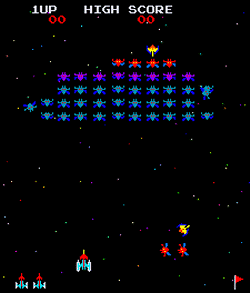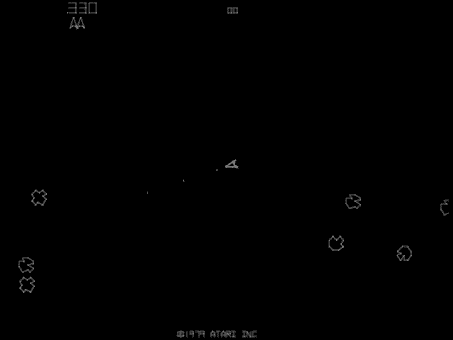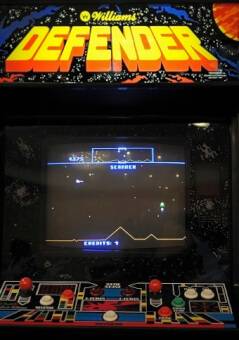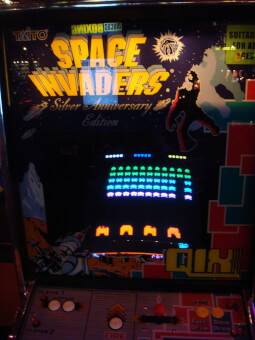1980 was a Golden Year in the Golden Age of the Video Game Arcade, which produced some of the greatest classics of all time. Here’s some of my favourites (and not so favourites).
Space Invaders
The original vertical space shooter, originally released in 1978, although, like Galaxian and Asteroids I didn’t come across them until 1980. Space Invaders laid down the challenge before you got anywhere near it. Larger than life digitised aliens jumped out at you from the cabinet, and you were mankind’s final hope.
For all intents and purposes, Space Invaders was, and still is, the quintessential video game. Just like the Fender Stratocaster in world of guitars, ask someone to draw you a video game, and chances are, they’d produce something like Space Invaders. Space Invaders also introduced the qualities that would go onto define other great games, the ‘one more go’ addiction, the ‘easy to pick up, but difficult to master’ gameplay mechanic. And Space Invaders really did keep it simple. You controlled a lone space ship at the bottom of the screen, with only left and right directions (thanks to the introduction of the joystick) plus a single shot laser cannon at your disposal. The complexity came in the four blocky structures above that protected you from the alien hordes raining down from above, until of course, they were decimated by hostile (or friendly) fire.
A simple green and black display still somehow managed to transport you into the blackness of space, with the structures above you giving you that comforting feeling of safety, before the panic of having nothing but you in the way an alien invasion.
As classic as gaming gets.

Galaxian
Although also released before 1980 (1979), It wasn’t long before I was able to experience the sequel to Space Invaders, and what a sequel it was! Galaxian, on the surface, took a big risk in removing the classic Space Invaders gameplay mechanic of those protective structures. Here, you were wide open to attack from the off, with the more strategic, considered pace of Space Invaders giving way to a much faster, smoother, reflex based, ‘arcade-y’ feel.
Although only a matter of months apart, the strides made in technology back in those days was mind-blowing. The monochrome green and black was replaced with technicolor, glittering stars added movement to the blackness of space, and the regimentally stiff, identical sprites making way for graceful, swooping formations of all types. Space Invaders operated on a simple x and y plane, but in Galaxian you were attacked at all, sometimes surprising angles.

Galaxian also increased the enemy types from 1 to 4, we had the blue ‘pawns’ similar to the Space Invaders. Next in line we had the swirling, aggressively acrobatic purples that would often disappear off the bottom of the screen and back up again, causing many a fatality. Lastly we had the high-scoring yellows, closely guarded by their subservient reds that resolutely stayed in formation.
Talking about scores, Galaxian was the first video game where high-score competition became a ‘thing’ for me. Getting to the top of the leader board was a huge achievement in those days, as there was a lot of competition. With name entry limited to three characters, I etched ADY for the duration of my gaming life into the memory banks of video games history, from Tynemouth to Cullercoats, Whitley Bay and South Shields.
Asteroids
Another 1979 video game I didn’t get to play until 1980, On first glance Asteroids seemed more like a science project than an actual game, especially when pitted against the perfectly formed, colourfully brash arcade thrills of Galaxian. This was a class of two approaches, the serious and grey(Atari) vs the fun and colourful (Namco). Asteroids certainly did NOT welcome you in, and certainly could’ve taken a leaf out of Namco’s book with regards to cabinet presentation and marketing. Even the interface was clunky, with buttons in place of a joystick. Far too many buttons in fact, Left Rotation, Right Rotation, Fire, Thrust and Shield, the latter being a (very temporary) invulnerability. It was one button too far, and more often than not you would forget all about it just when you needed it.
Not a great start then. But this was 1980, before we had the dirge of sequels and movie tie-ins we have today. Companies thought outside the box. Original ideas were ten-a-penny. Asteroids was just one of those genius original ideas that spawned a thousand copies.
Asteroids hooked you in with its realism and atmosphere. The business-like cabinet and over-complicated controls made you believe you were operating a real-life interface. Unlike Galaxian where the controls became second-nature after two-minutes, the controls of Asteroids were always a struggle, even after extended play. Maybe this was intentional, maybe not, but this approach of adding tension though a clunky interface has been copied throughout gaming history, most notably in the Resident Evil series.

The gameplay of Asteroids needs little introduction. You’re a lone triangular spaceship caught in the middle of an asteroid field you must shoot your way out of (by clearing the screen of asteroids). Graphically, the monochrome visuals look sparse but the realism of the vector graphics and super-smooth animation move it even further away from Galaxian. What also grabs you about Asteroids is the sheer number of outcomes that are possible from game to game. With Space Invaders and Galaxian it was easy to fall into familiar gameplay patterns, eventually it all got a bit samey. With Asteroids though, literally no two games were the same. Destroying an asteroid and watching it break up into smaller pieces was completely unpredictable, so much so that it made you stop and think ‘How did they program that?’
Of course, being caught up in an unpredictable, realistic-looking asteroid field with clunky controls would be bad enough, if it wasn’t for the odd enemy spaceship that would pop up from time to time to really throw you off-guard. I always thought this was a cheap decision by Atari, giving into Namco’s more arcadey tenancies and taking away from what was already a finely judged work.
To put the icing on the cake, the audio was also impressively understated and atmospheric. Asteriods was, and always will be, a masterpiece in video game design.
Pac-Man
From one of the most understated games in video game history, we have, perhaps one of the most overstated (and overrated). From the moment I first set eyes on Pac-Man, I never liked it. The cartoon imagery was too childish for even me (six years old at the time). I didn’t want cartoon ghosts being chased by a yellow ball with a face and limbs. I wanted star-ships, aeroplanes, and alien Armageddon Still, the cabinetry raised the bar in production values for the whole of the gaming industry, with Namco pouring millions into making Pac-Man the success it was. I just couldn’t see what all the fuss was about.
Once I actually got past the gloss and started playing Pac-Man, I was almost instantly turned off. There just didn’t seem a goal or point to it all bar clearing the screen maze of bills. Minor tension was added by being surrounded by Ghosts and released by collecting pills to eat them, but it was all a bit tame. Eating all four ghosts at once was the biggest achievement you could pull off in the game, and easily met early on. Maybe I just preferred shooting things.

Of course, Pac-Man didn’t go away, and went on to become a worldwide phenomenon, with Pac-Man himself becoming a mascot for gaming. I suppose I’ll always be thankful for that. The ultimate triumph of style over substance. To add insult to injury ‘Ms Pac-Man’ was released soon after. The only difference being a bow on Pac-Man’s head!
Phoenix
In the midst of the battle between the heavy hitters came something unexpected, an underdog with the humour and humility to rattle cages. Just a straight down the line, fun game.
You couldn’t call Phoenix original, but it was very, VERY clever. Phoenix took many elements from different games and made something unique. It took the block smashing mechanic of 1976’s Breakout and melded that to Galaxian to create what would be the first ever ‘Boss’. Instead of hitting the blocks though, you shot at the gigantic mothership and lesser (but still huge) birds of the title.
Your craft always raised a smile, seeming for all intents and purposes to be Rick Dastardly’s “The Mean Machine”.

Phoenix was a game your couldn’t fault. You inserted you 10p, had a blast shooting bad guys. You died. True it didn’t have the finesse of Galaxian, the class of Space Invaders or the cleverness and intricacy of Asteroids, but it did have an expertly judged difficulty curve and enemies that took one hell of a battering.
Defender
I was beginning to rate myself as a gamer, regularly topping the high-score charts on Galaxian and fairing better than most on Asteroids. That was until Defender came along.
Defender was an adult arcade game (to me at least), which intimidated me from the start. The interface made even Asteroids look straightforward. Here we had a joystick for up and down movement, with an accompanying ‘Reverse’ button. Not only was Defender the first horizontally scrolling shooter (and first scrolling shooter in general), but this button allowed you to switch your direction of travel from left to right and vice versa.
Over to the right, a thrust and fire button was joined by the safety net of a smart bomb, often wasted far too early in the panic of finding your bearings. Indeed my first few attempts simply involved moving up and down with the joystick while merrily firing away into the distance. Another first for Defender was in the continuous, rapid-fire beams of death that covered almost the whole screen, tearing down any enemies in their wake. Hugely satisfying.
Sooner or later though, one of your many foes would creep up from behind, forcing you to engage the thrust button, which turbo-propelled you into the unknown as the vector mountains whizzed by below. This was seat of you pants stuff, which made even Galaxian seem pedestrian. Eventually those horribly fast swarms of tiny aliens would give you no option but to hit the Hyperspace button, cruelly positioned in the centre-bottom of the control panel away from everything else!

Defender never gave you time to breathe, it was an assault on the senses and the reflexes, and yet still there was an extra layer of strategy to consider in the rescuing of tiny men waiting in the mountains. I never gave them a seconds thought.
The difficulty of Defender, combined with the unintuitive control layout and its sheer pace meant I never really enjoyed playing the game. But i can still appreciate its importance in gaming history as the template for many other games of it type (not least one of my all-time faves : R-Type).
Battlezone
Still in 1980, and yet another huge leap in technology; Not only did Battlezone add the third dimension no-less. It also combined this with vector graphics and a mercifully intuitive tank-esque interface (complete with periscope) to create the most immersive video gaming experience of the time. Two joysticks, one to control power (and reverse) and one direction (including the fire-button) completed the controls line up, allowing you to engage in a tank battle to the death, thankfully unhampered.

Battlezone was a very simple game. You could turn clockwise or anti-clockwise, go forward, backwards or fire. But this game was about atmosphere and thrilling action, presented in an impressive package. In summary, a suppose that’s what Battlezone was, just a perfectly formed, judged and executed marriage of hardware and software, which took the player out of the smokey arcade hall and into a war. Details like the box-style shells from your Tank disappearing into the distance towards an unsuspecting prey, holding your breath the moment before impact, and then the celebration of watching it fly apart on the horizon….
….Almost fourty years on I still remember that feeling.



Still can’t help but play a round or two of Space Invaders if I ever come across the cabinet. Thanks for sharing this trip down memory lane!
Thanks Eric. I go all the way through to 1987…. went downhill from there. Glad you can share in the memories.
Whatever we can say, Phoenix was very particular, it kept you plaing and plaing again, as hipnotized… there was an indescribable atmosphere that captivated you… full of small details, in the sounds and in the movements of the enemies, made it unique…
A good article and The click to tweet going to put on my sight . I hope it makes a difference and it will help to make it easier for others to share on that platform, too.-Thanks.
Thank you for sharing these story of encouragement from us.